Modeling of Real-Time Water Levels and Mapping of Storm Tide Pathways: A Collaborative Effort to Respond to the Threats of Coastal Flooding
Abstract
1. Introduction
NWS Forecasting
2. Materials and Methods
2.1. The NWS Model/TWL Forecasts (Grid Cell Size, Data Input, Choices)
2.2. Storm Tide Pathway Mapping
3. Results
3.1. The Storm of 4 January 2018
3.2. The Storm of 4 January 2018 and Total Water Level Forecasts
3.3. Mapping Storm Tide Pathways in Provincetown, MA
4. Discussion
Storm Tide Pathways and National Weather Service Storm Surge Predictions
- Action Stage: In preparation for a projected coastal storm tide some mitigation action should be considered.
- Minor Flooding Stage: Some public threat is anticipated, including but not limited to, minor flooding of low-lying roads and infrastructure. Minimal or no property damage is expected.
- Moderate Flooding Stage: Some anticipated inundation of roads and structures. Possible evacuation of some people and/or transfer of property to higher elevations.
- Major Flooding Stage: Extensive inundation of structures, properties, and roads anticipated and significant evacuation of people to higher elevations.
5. Conclusions
Author Contributions
Funding
Data Availability Statement
Acknowledgments
Conflicts of Interest
References
- Oppenheimer, M.; Glavovic, B.; Hinkel, J.; Roderik, V.; Magnan, A.; Abd-Elgawad, A.; Rongshu, C.; Cifuentes, M.; Robert, D.; Ghosh, T.; et al. Sea Level Rise and Implications for Low Lying Islands, Coasts and Communities; Cambridge University Press: Cambridge, UK, 2019; pp. 321–445. [Google Scholar]
- Mayo, T.L.; Lin, N. Climate change impacts to the coastal flood hazard in the northeastern United States. Weather Clim. Extrem. 2022, 36, 100453. [Google Scholar] [CrossRef]
- Mague, S.T.; Foster, R.W. Where’s the Shoreline? Sources of Historical High Water Lines Developed in the Context of Massachusetts Coastal Regulations. Int. Fed. Surv. 2008, 2, 1–18. [Google Scholar]
- Kirshen, P.; Watson, C.; Douglas, E.; Gontz, A.; Lee, J.; Tian, Y. Coastal flooding in the Northeastern United States due to climate change. Mitig. Adapt. Strateg. Glob. Change 2007, 13, 437–451. [Google Scholar] [CrossRef]
- Pershing, A.J.; Alexander, M.A.; Hernandez, C.M.; Kerr, L.A.; Le Bris, A.; Mills, K.E.; Nye, J.A.; Record, N.R.; Scannell, H.A.; Scott, J.D. Slow adaptation in the face of rapid warming leads to collapse of the Gulf of Maine cod fishery. Science 2015, 350, 809–812. [Google Scholar] [CrossRef] [PubMed]
- Marsooli, R.; Lin, N.; Emanuel, K.; Feng, K. Climate change exacerbates hurricane flood hazards along US Atlantic and Gulf Coasts in spatially varying patterns. Nat. Commun. 2019, 10, 3785. [Google Scholar] [CrossRef] [PubMed]
- NOAA. Center for Operational Oceanographic Products and Services (CO-OPS). Available online: https://tidesandcurrents.noaa.gov (accessed on 12 December 2023).
- Sweet, W.; Park, J.; Marra, J.; Zervas, C.; Gill, S. Sea Level Rise and Nuisance Flood Frequency Changes around the United States; National Oceanic and Atmospheric Administration: Silver Spring, MD, USA, 2014; p. 66. [Google Scholar]
- Sweet, W.; Simon, S.; Dusek, G.; Marcy, D.; Brooks, W.; Pendleton, M.; Marra, J. 2021 State of High Tide Flooding and Annual Outlook; National Oceanic and Atmospheric Administration: Silver Spring, MD, USA, 2021. [Google Scholar]
- NOAA. NOAA’s Office for Coastal Management. Available online: https://coast.noaa.gov/ (accessed on 12 December 2023).
- USBLS. Jobs & Wages (BLS) for Barnstable County, MA. U.S. Bureau of Labor Statistics. Available online: www.statsamerica.org/USCP/default.aspx?geo_id=25001 (accessed on 2 February 2023).
- NOAA. Data for Barnstable County. Economics: National Ocean Watch Dataset. Available online: https://coast.noaa.gov/digitalcoast/tools/enow.html (accessed on 12 December 2023).
- MA DLS. Massachusetts Division of Local Services. Available online: https://www.mass.gov (accessed on 12 December 2023).
- Stephens, S.H.; DeLorme, D.E.; Hagen, S.C. An Analysis of the Narrative-Building Features of Interactive Sea Level Rise Viewers. Sci. Commun. 2014, 36, 675–705. [Google Scholar] [CrossRef]
- Kumar, V.; Sharma, K.; Caloiero, T.; Mehta, D.; Singh, K. Comprehensive Overview of Flood Modeling Approaches: A Review of Recent Advances. Hydrology 2023, 10, 141. [Google Scholar] [CrossRef]
- Uchupi, E.; Giese, G.S.; Aubrey, D.G.; Kim, D.J. The late quaternary construction of Cape Cod, Massachusetts: A reconsideration of the WM Davis model. Geol. Soc. Am. Spec. Pap. 1996, 309, 1–69. [Google Scholar]
- Kim, S.C.; Chen, J.; Shaffer, W.A. An Operational Forecast Model for Extratropical Storm Surges along the U.S. East Coast. In Preprints Conference on Coastal Oceanic and Atmospheric Prediction, Proceedings of the 76th American Meteorological Society’s Annual Meeting, Atlanta, GA, USA, 28 January–2 February 1996; American Meteorological Society (AMS): Boston, MA, USA; pp. 281–286.
- Liu, H.; Taylor, A.; Spring, M. Development of the NWS’ probabilistic extra-tropical storm surge model and post processing methodology. In Proceedings of the 98th AMS Annual Meeting, Austin, TX, USA, 7–11 January 2018; pp. 7–11. [Google Scholar]
- Allen, E.A.; Hogan, L.G. Collaborative Innovations in Coastal Flood Forecasting: NWS Eastern Region’s Total Water Level Program and Partnerships with the Modeling Community. In Proceedings of the 104th Annual Meeting of the American Meteorological Society, Baltimore, MD, USA, 28 January–1 February 2024; Available online: https://ams.confex.com/ams/104ANNUAL/meetingapp.cgi/Paper/429364 (accessed on 3 March 2024).
- Hogan, L.G. From Prototype to Operational Decision Support Services—Five Years of Coastal Total Water Level Forecasting in Eastern Region of the National Weather Service. In Proceedings of the 104th Annual Meeting of the American Meteorological Society, Baltimore, MD, USA, 28 January–1 February 2024; Available online: https://ams.confex.com/ams/104ANNUAL/meetingapp.cgi/Paper/428922 (accessed on 3 March 2024).
- Craven, J.P.; Rudack, D.E.; Shafer, P.E. National Blend of Models: A statistically post-processed multi-model ensemble. J. Oper. Meteor. 2020, 8, 1–14. [Google Scholar] [CrossRef]
- Borrelli, M.; Mague, S.T.; Smith, T.L. A New Method of Providing Communities With High-Resolution Maps of Present and Future Inundation Pathways: Two Examples From Massachusetts. In AGU Fall Meeting Abstracts. V. 2015, Proceedings of the AGU Fall Meeting, San Francisco, CA, USA, 14–18 December 2015; PA41A-2166; American Geophysical Union (AGU): Washington, DC, USA, 2015. [Google Scholar]
- Borrelli, M.; Mague, S.T.; Smith, T.L.; Legare, B. A New Method for Mapping Inundation Pathways to Increase Coastal Resiliency, Provincetown Massachusetts; Technical Report Prepared for the Town of Truro, MA; Center for Coastal Studies: Provincetown, MA, USA, 2016; p. 29. [Google Scholar]
- Borrelli, M.; Mague, S.T.; Legare, B.J.; McCormack, B.; McFarland, S.J.; Solazzo, D. Mapping Storm Tide Pathways in Cape Cod Bay, Massachusetts; Technical Report Prepared for the Cape Cod Cooperative Extension 21-CL-05; Center for Coastal Studies: Provincetown, MA, USA, 2021; p. 73. [Google Scholar]
- Borrelli, M.; Mague, S.T.; Legare, B.; Smith, T.L. Mapping Inundation Pathways to Provide Communities with Real-Time Coastal Flood Forecasts: A Pilot Project with the National Weather Service; Technical Report Prepared for the Town of Truro, MA; Center for Coastal Studies: Provincetown, MA, USA, 2017; p. 32. [Google Scholar]
- Evans, D.; Lautenbacher, C.C.; Spinrad, R.W.; Szabados, M. Computational Techniques for Tidal Datums Handbook; NOAA Special Publication NOS CO-OPS; National Oceanic and Atmospheric Administration: Silver Spring, MD, USA, 2003; p. 2. [Google Scholar]
- Borrelli, M.; Smith, T.L.; Mague, S.T. Vessel-Based, Shallow Water Mapping with a Phase-Measuring Sidescan Sonar. Estuaries Coasts 2021, 45, 961–979. [Google Scholar] [CrossRef]
- Bent, G.C.; Taylor, N.J. Total Water Level Data from the January and March 2018 Nor’easters for Coastal Areas of New England; 2020-5048; U.S. Geological Survey: Reston, VA, USA, 2020; p. 47. [Google Scholar]
- Giese, G.S. Effects of the Blizzard of 1978 on the Coastline of Cape Cod. In Blizzard of 1978: Its Effects in the Coastal Environments of Southeastern New England; Boston State College: Boston, MA, USA, 1978; p. 5. [Google Scholar]
- Titus, J.G.; Richman, C. Maps of lands vulnerable to sea level rise: Modeled elevations along the US Atlantic and Gulf coasts. Clim. Res. 2001, 18, 205–228. [Google Scholar] [CrossRef]
- Amante, C.J. Uncertain seas: Probabilistic modeling of future coastal flood zones. Int. J. Geogr. Inf. Sci. 2019, 33, 2188–2217. [Google Scholar] [CrossRef]
- Mildenberger, M.; Sahn, A.; Miljanich, C.; Hummel, M.A.; Lubell, M.; Marlon, J.R. Unintended consequences of using maps to communicate sea-level rise. Nat. Sustain. 2024, 7, 1018–1026. [Google Scholar] [CrossRef]
- Jafarzadegan, K.; Merwade, V. A DEM-based approach for large-scale floodplain mapping in ungauged watersheds. J. Hydrol. 2017, 550, 650–662. [Google Scholar] [CrossRef]
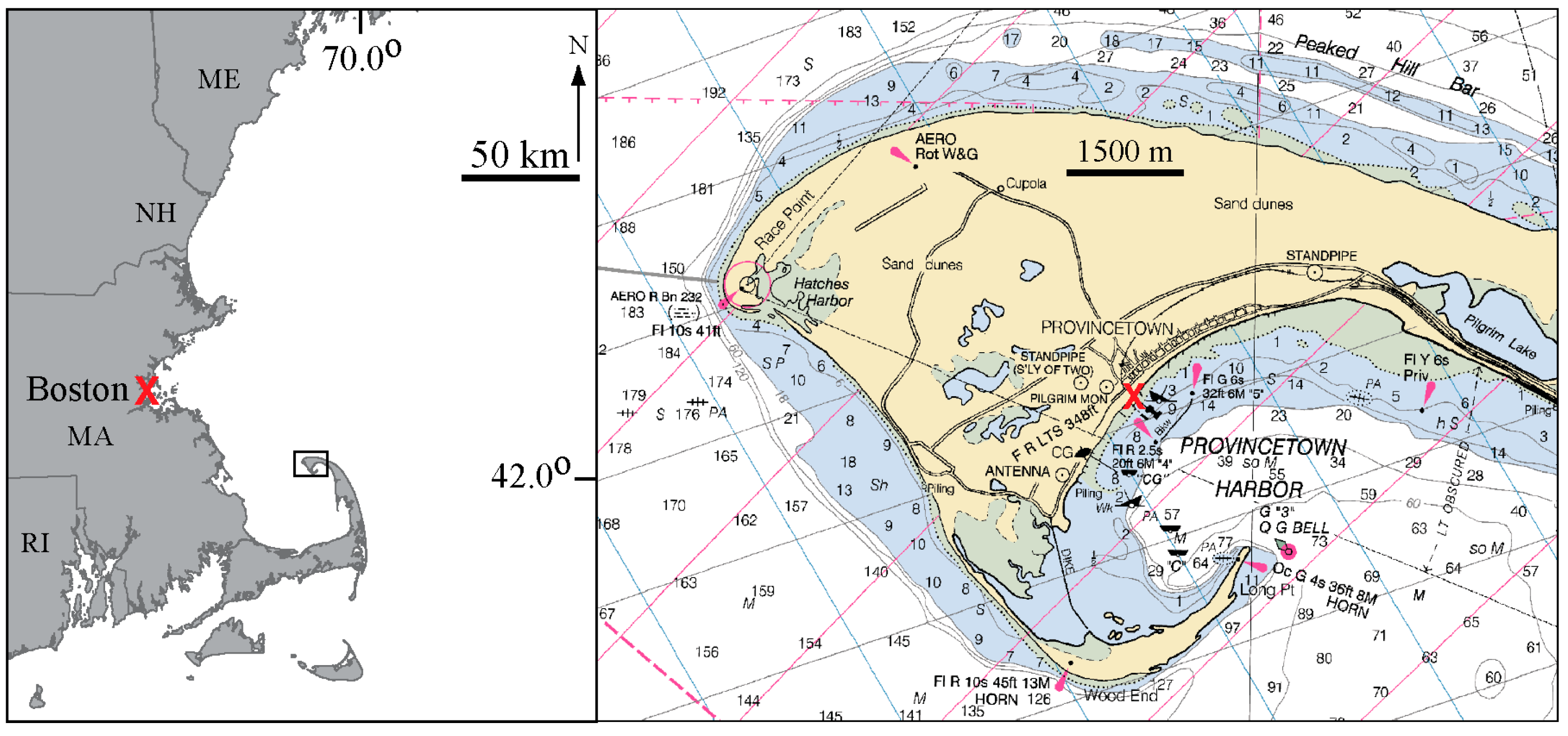
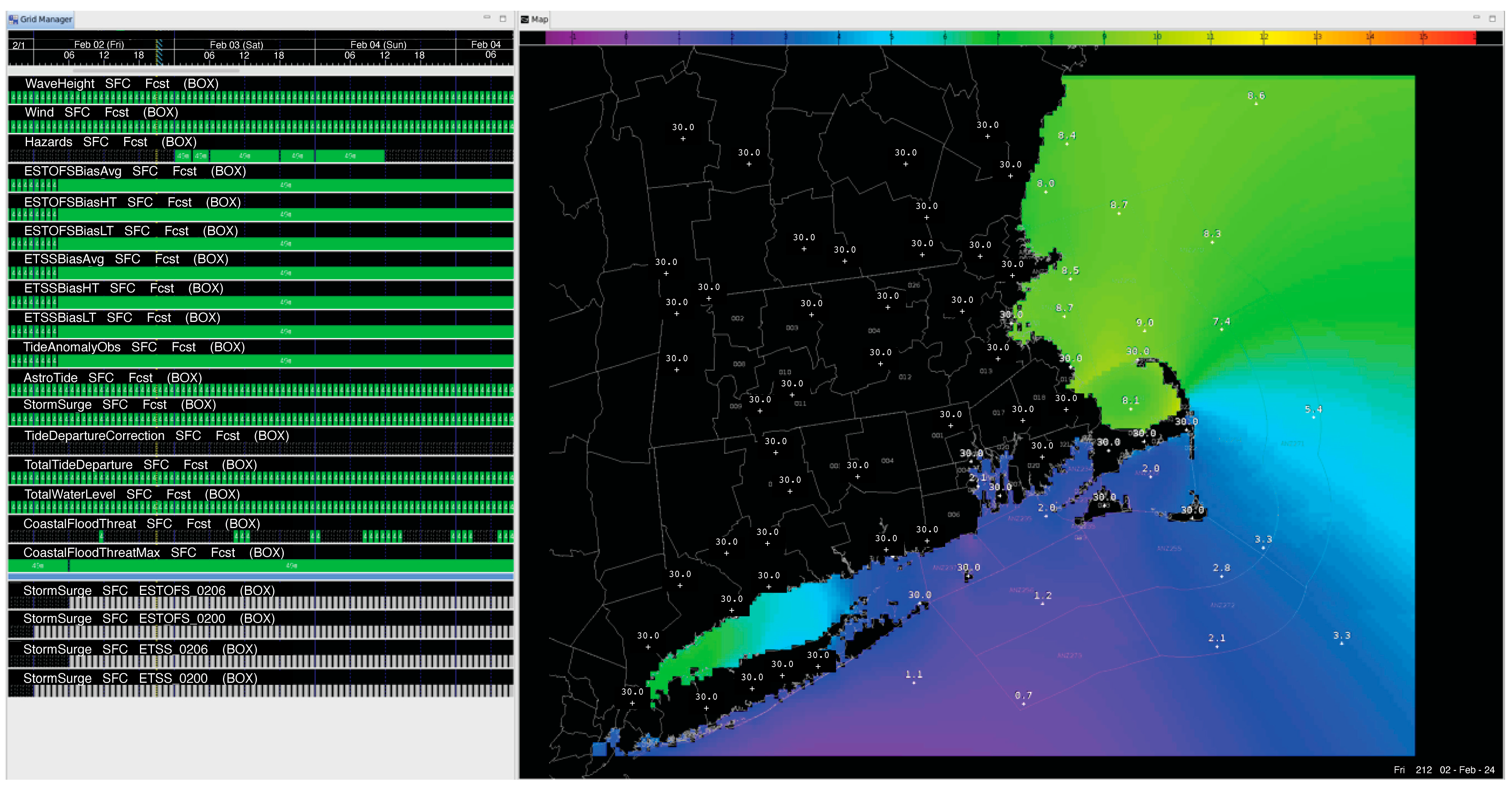
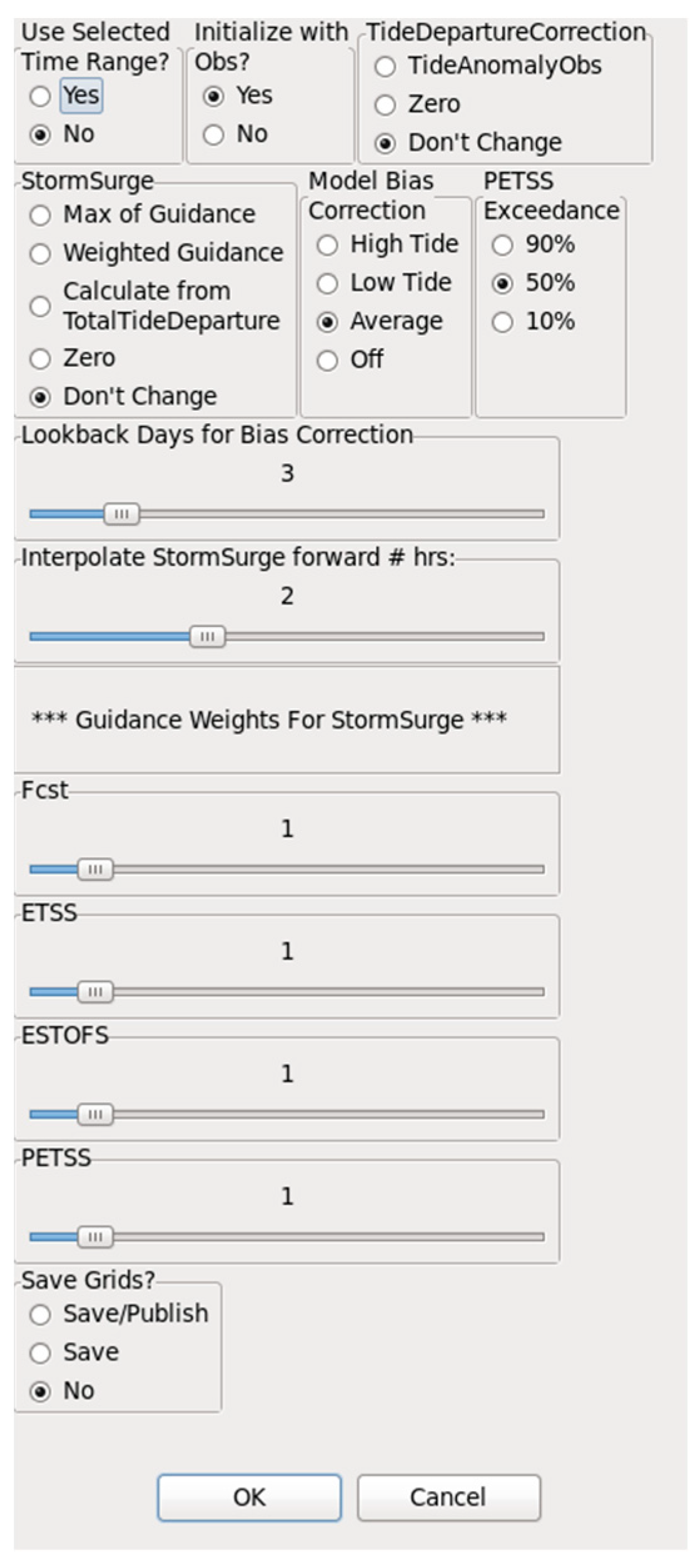


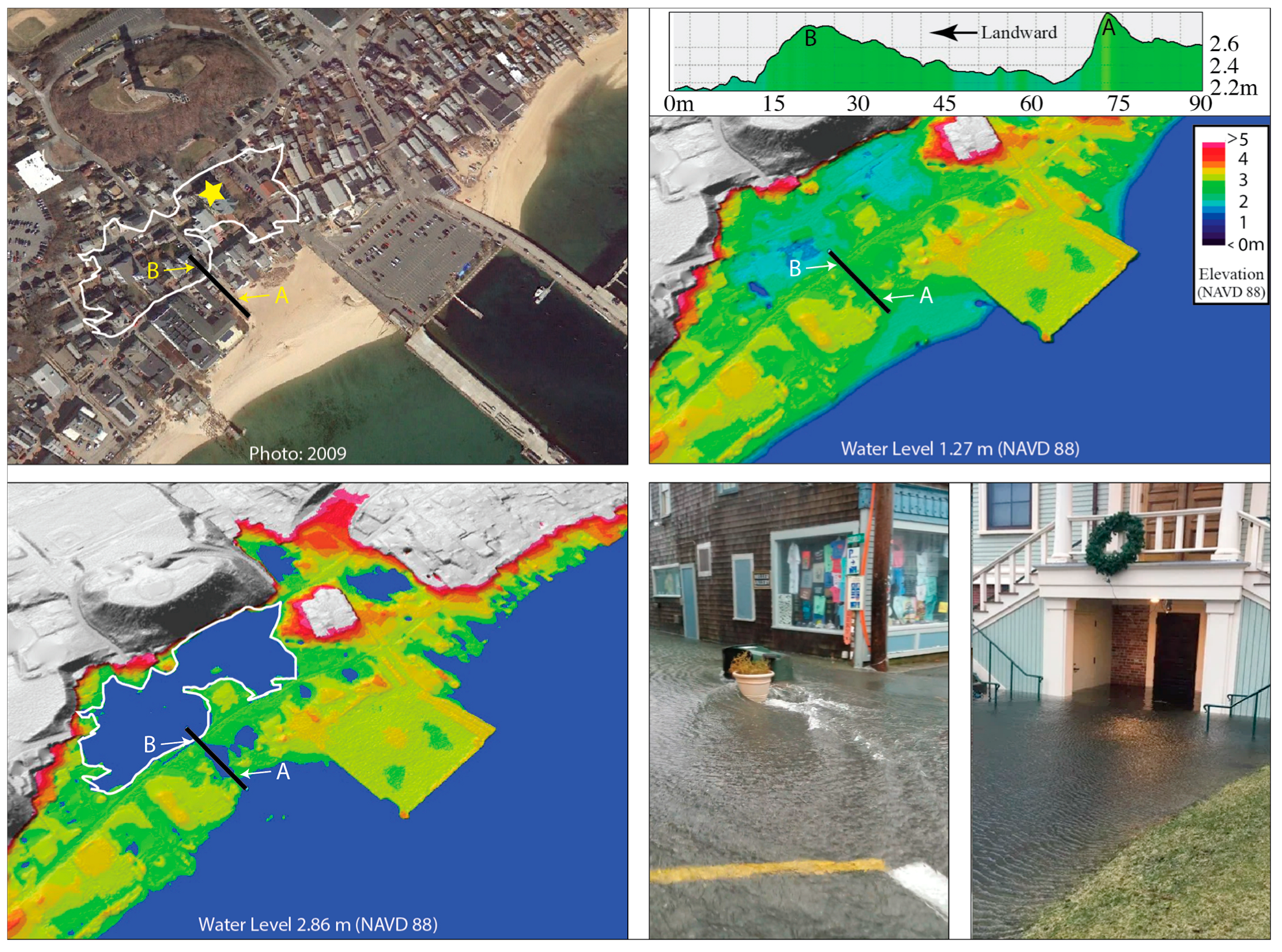
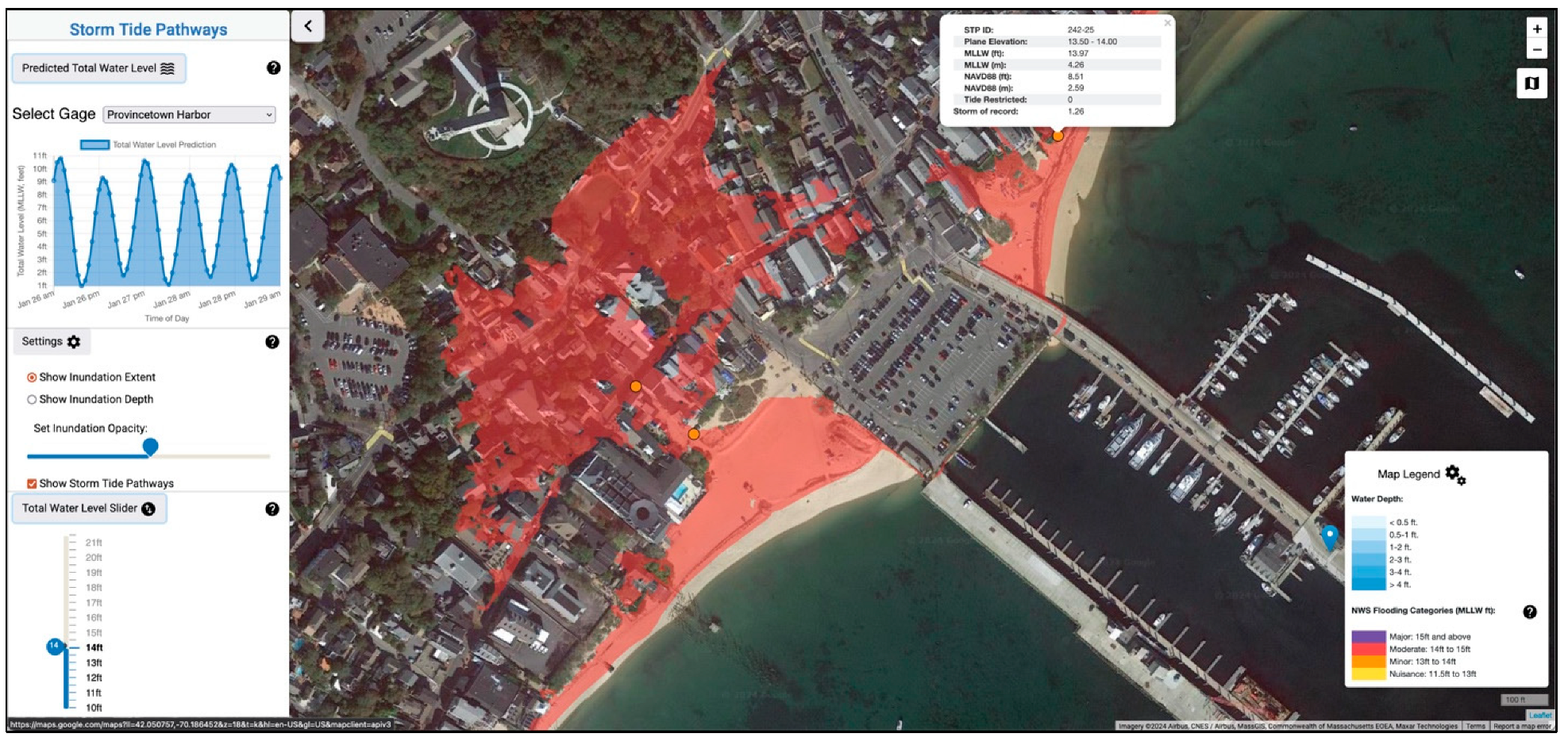
| Tide Station | Length of Record | Peak TWL 4 Jan 2018 | Peak TWL 7 Feb 1978 |
|---|---|---|---|
| Boston, MA | 1921—present | 2.94 | 2.90 |
| Provincetown, MA | 2014—present | 2.98 | 2.85 |
| Provincetown Harbor Tidal Profile—NOAA Station: 8446121 | |||||
|---|---|---|---|---|---|
| NAVD88 (ft) | NAVD88 (m) | MLLW (ft) | MLLW (m) | Comments | |
| Storm of Record +3 ft | 12.36 | 3.77 | 17.82 | 5.43 | Upper Limit of STP Analysis |
| Blizzard of 2018 | 9.77 | 2.98 | 15.23 | 4.64 | Storm of Record (current) |
| Blizzard of 1978 | 9.36 | 2.85 | 14.82 | 4.52 | Storm of Record (former) |
| Max. 2015 Predicted Tide | 6.44 | 1.96 | 11.90 | 3.63 | 2015 NOAA Tide Predictions |
| MHWS | 5.54 | 1.69 | 11.00 | 3.35 | NOAA Tide Station #8446121 |
| MHHW | 4.62 | 1.41 | 10.08 | 3.07 | NOAA Tide Station #8446121 |
| MHW | 4.16 | 1.27 | 9.62 | 2.93 | NOAA Tide Station #8446121 |
| MSL | −0.43 | −0.13 | 5.03 | 1.53 | NOAA Tide Station #8446121 |
| MTL | −0.48 | −0.15 | 4.98 | 1.52 | NOAA Tide Station #8446121 |
| MLW | −5.13 | −1.56 | 0.33 | 0.10 | NOAA Tide Station #8446121 |
| MLLW | −5.46 | −1.66 | 0.00 | 0.00 | NOAA Tide Station #8446121 |
| Elevation (MLLW, ft) | Action Level |
|---|---|
| 17 | Major life-threatening flooding occurs in Provincetown and Truro. Provincetown becomes isolated, with inundation along Routes 6 and 6A. Significant inundation occurs in the greater vicinity of Commercial Street and many adjacent side streets. Truro could become bisected with flooding along Route 6 and streets in the greater vicinity of the Pamet River and Little Pamet River marshes. Heed the advice of local officials and evacuate if asked to do so. |
| 16 | Major coastal flooding occurs in Provincetown and Truro, with Provincetown becoming isolated due to inundation of Routes 6 and 6A. Numerous roads in Provincetown are flooded, including but not limited to large stretches of Commercial Street, Routes 6 and 6A, as well as connecting side streets. Provincetown Airport is completely flooded. In Truro major flooding occurs in the greater vicinity of the Pamet River and Little Pamet River and associated marshland, with inundation along numerous nearby roads. |
| 15 | Major coastal flooding occurs in Provincetown and Truro. This includes flooding of Provincetown Airport, and inundation along stretches of numerous roads including Routes 6 and 6A, stretches of Commercial Street and nearby side streets. Provincetown may become isolated. In Truro portions of Route 6 and 6A are also flooded, with flooding of roadways including Dechampes Way, Great Hills and Salt Marsh Lanes, and Fisher, Old County, Castle, Great Hills, and Old Pamet Roads. |
| 14 | Expect Moderate coastal flooding in the vicinity of Provincetown and Truro. In Provincetown, flooding occurs at Provincetown Municipal Airport, Race Point Road, Provincelands Road, and portions of Commercial Street and Route 6A. In Truro flooding occurs in the vicinity of the Pamet River and Parker Marsh, with flooding on several roads including Castle Road, Eagle Neck Road, Phats Valley Road, and Mill Pond Road. Heed the advice of local officials, and evacuate if asked to do so |
| 13 | Expect Minor coastal flooding of some low-lying roadways. Minor coastal flooding occurs in Provincetown, in the vicinity of Race Point Road and Provincetown Airport. In Truro backwater flooding occurs along the Pamet River. |
Disclaimer/Publisher’s Note: The statements, opinions and data contained in all publications are solely those of the individual author(s) and contributor(s) and not of MDPI and/or the editor(s). MDPI and/or the editor(s) disclaim responsibility for any injury to people or property resulting from any ideas, methods, instructions or products referred to in the content. |
© 2025 by the authors. Licensee MDPI, Basel, Switzerland. This article is an open access article distributed under the terms and conditions of the Creative Commons Attribution (CC BY) license (https://creativecommons.org/licenses/by/4.0/).
Share and Cite
Dellicarpini, J.; Borrelli, M.; T. Mague, S.; McKenna, S. Modeling of Real-Time Water Levels and Mapping of Storm Tide Pathways: A Collaborative Effort to Respond to the Threats of Coastal Flooding. Coasts 2025, 5, 36. https://doi.org/10.3390/coasts5040036
Dellicarpini J, Borrelli M, T. Mague S, McKenna S. Modeling of Real-Time Water Levels and Mapping of Storm Tide Pathways: A Collaborative Effort to Respond to the Threats of Coastal Flooding. Coasts. 2025; 5(4):36. https://doi.org/10.3390/coasts5040036
Chicago/Turabian StyleDellicarpini, Joseph, Mark Borrelli, Stephen T. Mague, and Stephen McKenna. 2025. "Modeling of Real-Time Water Levels and Mapping of Storm Tide Pathways: A Collaborative Effort to Respond to the Threats of Coastal Flooding" Coasts 5, no. 4: 36. https://doi.org/10.3390/coasts5040036
APA StyleDellicarpini, J., Borrelli, M., T. Mague, S., & McKenna, S. (2025). Modeling of Real-Time Water Levels and Mapping of Storm Tide Pathways: A Collaborative Effort to Respond to the Threats of Coastal Flooding. Coasts, 5(4), 36. https://doi.org/10.3390/coasts5040036






